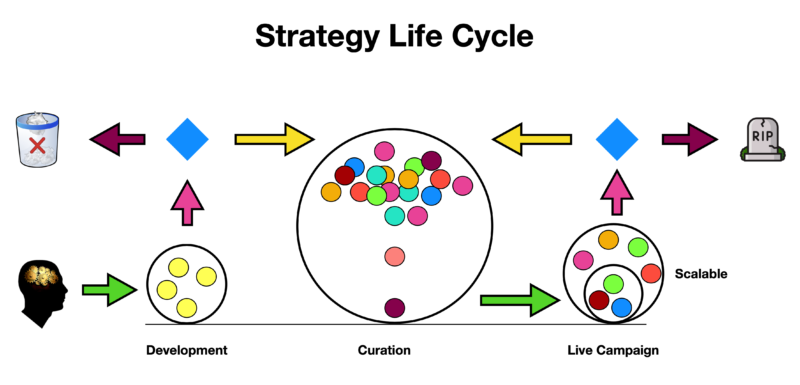Automation, playbook, process
The Strategy Lifecycle
How many strategies do you need to succeed at trading?
There are hundreds, perhaps even thousands of strategies you could readily find with a simple Google search. If you were to take these, along with the hundreds of indicators that exist, market inflections, economic reports, seasonal events…on and on, the combinations of possible strategies is limitless.
How do you pick the ones that will work for you, which are the best? Do you need more strategies or fewer to be successful?
Well, here’s a truth that all systematic traders know, and that is there is no one strategy that will work in every situation, in fact situational strategies may not even work for that situation they were designed for over long periods of time. They might work for a few months, maybe a year or two, then stop working. This is common, the norm, not an exception…it is the reality and what makes trading so difficult.
Employing multiple non-correlated strategies is the holy grail. Hedge funds and institutions know this, but it requires an incredible number and quality of resources to make it happen. You have limited resources, but you also have an advantage, agility.
You could find a strategy, invest a lot of time and effort developing and perfecting your technique and method, achieve some success, then for some unidentifiable reason it just stops working…back the the drawing board.
Some strategies work across markets, some work in only specific markets under very exacting conditions and only during certain times of the year or day or day of the week, or any other delineation. all of this points to an obvious fact, that strategies have a life, and each strategy may have a different life time and effectiveness, but they all have a life cycle, and from that concept you can manage them.
So, how do you manage this? How do you pick a strategy or strategies and manage the life cycle of trading strategies?
Strategy Life Cycle
I have for the longest time recommended that my students to develop trading campaigns, which are a kind of trading life cycle, designed to time-box your trading so that you can establish a baseline and measure your progress from one campaign to the next. Campaigns last a month and culminate with a retrospective or review at the end of each campaign, this is so that you can evaluate your performance and give you the opportunity to introduce improvements to your future trading campaigns—a continuous improvement process.
Trading is all about developing habits and processes, and continually perfecting these two things. A trading campaign is a way to do this.
You also need another process that provides a constant stream of good ideas, strategies to employ, whether you’re a discretionary or systematic trader, this is the reality. A constant stream of good trading ideas, that you can pick from, is essential.
What does a strategy life cycle look like?

There are three phases to your Strategy Lifecycle:
- Development – strategies in the development phase can be things you have discovered or made up, they could also be strategies you borrowed, or stole. In any case they must be worked on and made real, categorized and parametrized. I like to call this your Strategy Factory.
- Curation – This is typically a paper trading account where you backtest, forward walk the strategies to determine their suitability for your trading campaigns. It’s possible to run these in a way that provides little risk to your trading capital, while using real capital, but in super small scale, such as in an ECN account. The purpose is to determine what kind of markets the strategy is best suited for and to gain an understanding of how to trade it in the context of other strategies. In other words, to discover the degree of correlation it has with other strategies currently deployed. The goal is to have a low correlated group of strategies working together.
- The Campaign – This is the show, live trading. These are the strategies you trade now when the market sets up, that are part of your Playbook. They are your best strategies for the current market and work best in conjunction with the group of strategies deployed into your current campaign.
The graphic implies that you are constantly in development mode, feeding the lifecycle. The goal is to always have candidate strategies in curation to feed your live campaigns. The strategies running in your campaign are the best for the current market and for you. At any time a strategy could stop working or become inappropriate for the current market conditions, or be too highly correlated with other strategies, and so you would return it to the curation phase, or delete it all together if it simply no longer works.

How do I get access to the live trading room? Thanks
It’s on my Discord server, here’s an invite
https://discord.gg/uvFKUwC